Tefal 7114000516 User manual
- Category
- Pressure cookers
- Type
- User manual
This manual is also suitable for

www.t-falusa.co
m
Réf INSFTW1 • 12/2013 • Subject to modifications
ESPACE GRAPHIQUE
EN
ES
EN p. 1
ES p. 15
A
B
H
J
N
O
C
D
E
F
G
I
K
L
M
Pressure Cooker
User’s Guide
Guía del usuario
Descriptive diagram - Esquema descriptivo
TF_EXPERT-PRO_INSFTW1_USA 04/12/13 11:48 PageC1

Fig 1 Fig 2 Fig 3
CLICK
Fig 4 Fig 5
1/3
2
/3
1
/2
Fig 6
Fig 7 Fig 8 Fig 9
Fig 10 Fig 11 Fig 12
Fig 13 Fig 14
Table of contents
Important safeguards p1
Descriptive diagram p2
Characteristics p2
Compatible heat sources p2
T-fal accessories p3
Operating instructions p3
Opening p3
Closing p3
Minimum filling p4
Maximum filling p4
Food preparation instructions p4
Using the operating valve p4
Using for the first time p5
Before cooking p5
During cooking p6
Finishing cooking p6
Care and cleaning p7
Cleaning the pressure cooker p6
Safety features p8
Recommendations for use p9
Regulation markings p 10
T-fal and your frequently asked questions p 11
Table of cooking times p 12
Limited Warranty p 13
TF_EXPERT-PRO_INSFTW1_USA 04/12/13 11:48 PageC4

1
EN
ES
ES
PT
EL
AR
FA
IMPORTANT SAFEGUARDS
When using pressure cookers, basic safety precautions should
always be followed :
1. Read all instructions.
2. Do not touch hot surfaces. Use handles or knobs.
3. Close supervision is necessary when the pressure cooker is used
near children.
4. Do not place the pressure cooker in a heated oven.
5. Extreme caution must be used when moving a pressure
cooker containing hot liquids.
6. Regularly check that the handles of the pressure cooker are fitted
correctly. Tighten them if necessary.
7. Do not use pressure cooker for other than intended use.
8. This appliance cooks under pressure. Improper use may result in
scalding injury. Make certain unit is properly closed before opera-
ting. See “Operating Instructions.”
9. Do not fill the unit over 2/3 full. When cooking foods that expand
during cooking such as rice or dried vegetables, do not fill the unit
over ½ full. Over filling may cause a risk of clogging the vent pipe
and developing excess pressure. See “Food Preparation Instructions.”
10. Be aware that certain foods, such as applesauce, cranberries, pearl
barley, oatmeal or other cereals, split peas, noodles, macaroni, rhu-
barb, or spaghetti can foam, froth, and sputter, and clog the pres-
sure release device (steam vent). These foods should not be cooked
in a pressure cooker.
11. Always check the pressure release devices for clogging
before use.
12. Do not open the pressure cooker until the unit has cooled and all
internal pressure has been released. If the handles are difficult to
push apart, this indicates that the cooker is still pressurized – do
not force it open. Any pressure in the cooker can be hazardous.
See “Operating Instructions”.
13. Do not use this pressure cooker for pressure frying with oil.
14. When the normal operating pressure is reached, turn the heat down
so all the liquid, which creates the steam, does not evaporate.
15. Always pour a minimum amount of a liquid of at least
8.5 oz in the unit. See "Operating Instructions".
SAVE THESE INSTRUCTIONS.
TF_EXPERT-PRO_INSFTW1_USA 04/12/13 11:48 Page1

2
Descriptive diagram
Characteristics
Pressure cooker base diameter - model references
Standards information:
Upper operating pressure limit: 100 kPa (14,5 psi).
Maximum safety pressure limit: 170 kPa (25 psi).
Compatible heat sources
• The pressure cooker can be used
on all heat sources.
• When using an electric hob or induction, make sure
that the size of the hot plate does not exceed the
size of the pressure cooker base.
• On a ceramic or halogen hob, always make sure that
the pressure cooker base is clean and dry.
• On a gas hob, the flame should not extend past the
diameter of the pressure cooker base.
A - Operating valve
B - Operating valve seat
C - Safety valve
D - Pressure indicator
E - Opening button
F - Long lid handle
G - Lid positioning mark
H - Operating valve positioning mark
I - Lid gasket
J - Steam basket
K - Steam basket support
L - Long pressure cooker body handle
M - Pressure cooker body
N - Short pressure cooker body handle
O - Maximum filling mark
Capacity
Cooker
diameter
Base
diameter
Model Item number
Lid and body
material
6.3 qt 6L 8.6" 7.5" P25107 YS223H64
Stainless
steel
GAS SOLID
HOTPLATE
CERAMIC
or
HALOGEN
INDUCTION
ELECTRIC
HOTPLATE
TF_EXPERT-PRO_INSFTW1_USA 04/12/13 11:48 Page2

3
EN
ES
ES
PT
EL
AR
FA
T-fal accessories
• The following pressure cooker
accessories are available :
• To replace other parts or have repairs performed, please
call on your local T-fal Approved Service Center.
• Only use T-fal genuine parts designed for your
product model.
Operating Instructions
This appliance cooks under pressure. Improper use may result in scalding injury.
Make certain unit is properly closed before operating.
Always pour a minimum amount of a liquid of at least 8.5 oz in the unit.
Opening
• Using your thumb, pull on the opening knob (E)
and move it back to the position - Fig 1.
Hold the long pressure cooker handle (L) with your
left hand, while turning the long lid handle (F)
counter clockwise with your right hand, until it
opens - Fig 2. Then lift the lid off.
• Do not open the pressure cooker until the unit has
cooled and all internal pressure has been released. If
the handles are difficult to push apart, this indicates
that the cooker is still pressurized - do not force it
open. Any pressure in the cooker can be
hazardous.
Closing
• Place the lid down flat on the pressure cooker
making sure to line up the triangles on the lid and
the pressure cooker handle - Fig 3
• Turn the lid to the left until it stops - Fig 3
• Push the opening knob (E) to move it to the
position - Fig 4
Accessory Reference number
Gasket X9010103
TF_EXPERT-PRO_INSFTW1_USA 04/12/13 11:48 Page3

4
Minimum filling
• Always pour a minimum amount of liquid of at least
8.5 oz (about 1 cup) into the pressure cooker.
For Steaming:
• At least 25 oz (about 3 cups) of water must be
poured in.
• Place the basket (J) onto the steaming support piece
(K) provided for this purpose - Fig 5
Maximum filling
• Never fill your pressure cooker more than two-thirds
full (maximum mark) - Fig 6
For some food:
For food that expands during cooking, like rice, dried
vegetables or stewed fruit... never fill your pressure
cooker more than half full - Fig 6
Food Preparation Instructions
Do not fill the unit over 2/3 full. When cooking foods that expand during
cooking such as rice or dried vegetables, do not fill the unit over ½ full. Over
filling may cause a risk of clogging the vent pipe and developing excess
pressure.
Using the operating valve (A)
To cook delicate food and vegetables:
• Set the valve to (A and H). Operates at 70 kPa
(10 psi).
To cook meat and frozen foods:
• Set the valve to (A and H). Operates at 100 kPa
(14.5 psi)
To release steam:
• Set the valve to .
To remove the operating valve:
• Let the appliance cool down before removing the
valve (A).
• Press down on the valve and turn it to align to the dot
position (H) - Fig 7
• Remove the valve.
Food placed in the
steam basket must
not touch the pres-
sure cooker lid.
TF_EXPERT-PRO_INSFTW1_USA 04/12/13 11:48 Page4

5
EN
ES
ES
PT
EL
AR
FA
To refit the operating valve:
• Place the operating valve in place making sure to
align it with the dot position (H).
• Press the valve then turn it until the desired position
is reached.
Using for the first time
• Fill the pressure cooker to the two-thirds mark (the
maximum mark) with water.
• Place the basket support (K) in the bottom of the
pressure cooker and place the basket (J) on top of it.
• Close the pressure cooker.
• Move the operating valve (A) to position .
• Place the pressure cooker on a heat source set to
maximum power.
• Once steam starts to escape from the valve, turn the
heat down and set a timer for 20 minutes.
• Once the 20 minutes are up, turn off the heat.
• Turn the operating valve (A) to position .
• Once the pressure indicator (D) drops down: your
pressure cooker is no longer under pressure.
• Open the pressure cooker.
• Rinse the pressure cooker with water and dry it.
Before cooking
• Before each use of the pressure cooker, always
remove the valve (A) (Refer to the “Using the
operating valve” heading) and visually check that
the operating valve seat (B) is not blocked. If
necessary, clean it with a toothpick - Fig 8
• Check that the safety valve (C) can move: Refer to
the “Care and Cleaning” heading.
• Refit the operating valve (A) and select the position
or .
• Always make sure that the pressure cooker is
properly closed before starting to heat it. The
opening button (E) must be in the position.
• Place the pressure cooker on a heat source set to
maximum power.
TF_EXPERT-PRO_INSFTW1_USA 04/12/13 11:48 Page5

6
During cooking
• Select your recipe. Set the operating valve to if the
recipe calls for low pressure or if it calls for high
pressure. Refer to the table on page 12 for suggested
cooking times if you are not following a recipe.
• Decide if you are going to steam cook or immersion
cook.
For steaming:
- Add at least 3 cups of water.
- Place the support piece in the pressure cooker . Fill
the steamer basket with your food and set the basket
on top of the support. Remember not to overfill the
basket.
- Close the pressure cooker lid, set on the stovetop, and
turn heat to high.
- Once the steam starts to escape from the valve, turn
the heat down and set your timer per the recipe’s
instructions.
- Once the time is up turn off the heat and turn the
operating valve to position.
- Once the indicator (D) drops down your pressure
cooker is no longer under pressure.
- Open the pressure cooker. Rinse with water and dry.
For immersion cooking:
- Add the food you are cooking, being careful not to
fill the pressure cooker more than 2/3 full. If you wish
to brown meats or saute onions as a first step, you
can add some oil to the pressure cooker and saute
accordingly. You must do any initial browning or
sauteeing with the lid off before the pressure cooking
stage.
- Add the liquid that the recipe calls for. It must be at
least 1 cup. Keep in mind that liquids can include
water, stock, or wine, but never oil.
- Follow steps 3-7 above
Finishing cooking
To release the steam:
• Once the heat is turned off, you have two options:
• Slow pressure release: gradually turn the operating
The pressure indicator
(D) prevents pressure
from rising in the pres-
sure cooker if it is not
properly closed.
TF_EXPERT-PRO_INSFTW1_USA 04/12/13 11:48 Page6

7
EN
ES
ES
PT
EL
AR
FA
valve (A) to the position. Once the pressure
indicator (D) drops down: your pressure cooker is no
longer under pressure.
• Fast pressure release: place your pressure cooker
under a stream of cold water. Once the pressure
indicator (D) drops down: your pressure cooker is no
longer under pressure. Turn the operating valve (A)
to the position.
• Now you can open it.
Care and Cleaning
Cleaning the pressure cooker
For best appliance operation, be sure to follow these
cleaning and maintenance recommendations every
time the pressure cooker is used.
• Always wash the pressure cooker after use with
warm water and soap. Do the same for the basket.
• Never use bleach or chlorine products.
• Never overheat the pressure cooker body when it is
empty
.
To clean the inside of the pressure cooker:
• Clean it with a scouring pad and warm soapy water.
• If the inside of the stainless steel cooker shows
iridescent reflections, clean it with vinegar.
To clean the outside of the pressure cooker:
• Clean it with a sponge and warm soapy water.
To clean the lid:
• Wash the lid under a gentle stream of running warm
water using a sponge and soap.
To clean the lid gasket:
• After using the pressure cooker, always clean the
gasket (I) and its groove.
• To refit the gasket, refer to the drawings - Fig 9 - 10
You can wash the
pressure cooker body
and the basket in a
dishwasher.
Never wash the lid
in a dishwasher.
For a longer pres-
sure cooker life, do
not overheat your
pressure cooker pan
when it is empty.
The pressure indicator
(D) prevents the pres-
sure cooker from
being opened if it is
still under pressure.
If you observe unu-
sual spraying during
decompression: move
the valve to position
then release pres-
sure again making
sure to ensure that
there is no more
spraying.
Browning and scrat-
ching that may ap-
pear following long
periods of use are
normal and will not
affect the perfor-
mance of the pres-
sure cooker.
TF_EXPERT-PRO_INSFTW1_USA 04/12/13 11:48 Page7

8
To clean the operating valve (A):
• Remove the operating valve (A): Refer to the “Using
the operating valve” heading.
• Clean the operating valve (A) under running tap
water - Fig 11
To clean the operating valve seat located in the lid:
• Remove the valve (A).
• Visually inspect the seat and the steam release pipe
in daylight to make sure that it is round and clear. If
necessary, clean it with a toothpick - Fig 8
To clean the safety valve (C):
• Clean the part of the safety valve located inside the
lid by placing it under running water.
• Check that it works properly by lightly pressing on the
plunger which should move without difficulty - Fig 12
To replace your pressure cooker gasket:
• Replace your pressure cooker gasket every year.
• Replace your pressure cooker gasket if it shows any
signs of splitting or damage.
• Always use a T-fal genuine gasket that matches your
model of pressure cooker.
To store your pressure cooker:
• Turn the lid over and place it on the pressure cooker
body.
• Note: The presence of stains on the inside of the
pressure cooker base has no affect on the quality of
the metal. This is simply a scale deposit. To remove
these deposits, you can use a scouring pad and some
diluted vinegar.
Safety Features
Your pressure cooker is provided with a number of
safety mechanisms:
• Closure safety:
- If the appliance is not properly closed, the
pressure indicator (D) cannot rise and therefore
the pressure cooker will never come up to
pressure.
• Opening safety:
- While the pressure cooker is under pressure, the
Never use a sharp
or pointed object
to do this.
Always have your
pressure cooker
checked by a T-fal
Approved Service
Center after 10
years of use.
TF_EXPERT-PRO_INSFTW1_USA 04/12/13 11:48 Page8

9
EN
ES
ES
PT
EL
AR
FA
opening knob cannot be activated. Never force
the pressure cooker open. Never tamper with the
pressure indicator. Always make sure that the
pressure inside the pressure cooker has been
released.
• Two added safety features:
- First feature: the safety valve (C) releases
pressure and the steam will escape horizontally
from the top of the lid - Fig 13
- Second feature: the gasket (I) lets steam escape
vertically from the side of the lid - Fig 14
If one of the two added safety systems are triggered:
• Turn off the heat.
• Allow the pressure cooker to cool down completely.
• Open it.
• Check and clean the operating valve (A), the
operating valve seat and pipe (B), the safety valve
(C) and the gasket (I).
Recommendations for Use
1 - The steam is very hot when it leaves the operating
valve.
2 - As soon as the pressure indicator rises, you can no
longer open your pressure cooker.
3 - Just like for any other cooking appliance, always
pay close attention to it, especially during use in the
presence of children. Never leave unattended while
in use.
4 - Beware of the horizontal steam jet.
5 - To move the pressure cooker, always use both of the
handles.
6 - Never leave food in your pressure cooker.
7 - Never use bleach or chlorine products for they could
affect the quality of the stainless steel.
8 - Never wash the lid in the dishwasher. Never leave
the lid to soak in water.
9 - Replace the gasket every year.
10 - A pressure cooker may only be cleaned when cold
and empty.
11 - Always have your pressure cooker checked by a T-fal
Approved Service Center after ten years of use.
TF_EXPERT-PRO_INSFTW1_USA 04/12/13 11:48 Page9

10
Regulation Markings
Marking Location
Manufacturer's identification or trade-
mark
Lid handle
Year and batch of manufacture Inside the lid
Model reference
Operating pressure (PF)
Max. safety pressure (PS)
Capacity
On the outside of the pressure
cooker body
TF_EXPERT-PRO_INSFTW1_USA 04/12/13 11:48 Page10

11
EN
ES
ES
PT
EL
AR
FA
T-fal and Your Frequently Asked Questions
Problems Recommendations
If the pressure cooker has
heated up under pressure
with no liquid inside:
• Have your pressure cooker inspected by a T-fal
Approved Service Center.
If the pressure indicator
did not rise and nothing
escapes from the valve
during cooking:
• This is normal for the first few minutes.
• If the problem persists, check that:
- There is enough heat, if not, turn up the heat.
- The amount of liquid in the pressure cooker is ade-
quate.
- The operating valve is set to or .
- The pressure cooker is properly closed and the ope-
ning button is in the position.
- The lid gasket has not perished.
If the pressure indicator
has risen but still nothing
escapes from the valve
during cooking:
• This is normal for the first few minutes.
• If the problem persists, place your appliance under cold
water. Then open it.
• Clean the operating valve and valve seat - Fig 8 and
check that the safety valve can be pushed in without
difficulty - Fig 12.
If steam escapes from
around the lid, check:
• That the lid is properly closed and the opening button
is in the position.
• The gasket is correctly fitted into the lid.
• That the gasket is in good condition, and if necessary,
replace it.
• That the lid, the gasket, its seat in the lid, the safety
valve and the operating valve are clean.
• That the rim of the pressure cooker body is in good
condition and not damaged.
If food has burnt on the
bottom of the pressure
cooker:
• Leave the pressure cooker to soak for a while before
washing.
• Never use bleach or chlorine products.
If you cannot open the
lid:
• Check that the pressure indicator is down.
• If not, release pressure and if necessary cool the pres-
sure cooker under a stream of cold water.
If food is not cooked or
has burnt, check:
• The cooking time.
• The heat level.
• Whether the operating valve was in the right position.
• The amount of liquid.
TF_EXPERT-PRO_INSFTW1_USA 04/12/13 11:48 Page11

12
Meat - Fish
Table of Cooking Times
Vegetables
Cooking
FRESH PRODUCE
Valve position 1
FROZEN PRODUCE
Valve position 2
Artichoke
- steam
14 min.
- immersion
12 min.
Asparagus - immersion
4 min.
Beets - steam
16 - 24 min.
Broccoli - steam
3 min. 3 min.
Brussels sprouts - steam
5 min. 4 min. - immersion
Cabbage, green
sliced - steam
5 min.
leaves - steam
5 min.
Carrots sliced - steam
5 min. 4 min.
Cauliflower - immersion
3 min. 4 min.
Celery
- steam
5 min.
- immersion
8 min.
Endives - steam
10 min.
Green beans - steam
6 min. 7 min.
Leek sliced - steam
2 ½ min.
Mushrooms
sliced - steam
1 min. 4 min.
whole - immersion
1 ½ min.
Peas - steam
1 ½ min. 4 min.
Potatoes quartered
- steam
10 min.
- immersion
5 min.
Pumpkin (mashed) - immersion
6 min.
Rice - immersion
5 min.
Spinach
- steam
4 min. 6 min.
- immersion
3 min.
Turnips
- steam
5 min.
- immersion
5 min.
White beans semi-dry - steam
16 min.
Zucchini
- steam
5 min.
7 min
- immersion
2 min.
FRESH
Valve position 2
FROZEN
Valve position 2
Beef (roast 2 lbs) 8 min. 23 min.
Chicken (whole 2.6 lbs) 16 min. 36 min.
Lamb (leg 2.8 lbs) 20 min. 28 min.
Monk fish (fillets 1.5 lbs) 4 min 5 min
Pork (roast 2 lbs) 20 min. 36 min.
Salmon (4 steaks 1.5 lbs) 5 min 6 min
Tuna (4 steaks 1.5 lbs) 5 min 7 min
steam = in the steam basket
immersion = in water
TF_EXPERT-PRO_INSFTW1_USA 04/12/13 11:48 Page12

13
EN
ES
ES
PT
EL
AR
FA
Limited Warranty
•The body of your new T-fal pressure cooker comes
with a ten year limited warranty for use under the
conditions outlined in these instructions. This war-
ranty covers:
- Any defects relating to the metal structure of the
pressure cooker body.
- Any premature deterioration of the metal base.
•For other parts, a one year parts and labor war-
ranty is provided. This warranty covers any defects
or manufacturing faults.
•The contractual warranty is provided only on pre-
sentation of a valid proof of purchase which shows
the date of purchase.
The warranty excludes:
•The normal life of the gasket, pressure control valve or
locking indicator gasket is limited. These parts are ex-
cluded from the warranty and will require periodic re-
newal.
•Any damage caused by the failure to follow the major
recommendations made or due to negligent use,
especially:
- Dropping, falls, bangs or knocks, placing in an
oven…
- Washing the lid in the dishwasher.
•T-fal
®
SHALL NOT BE LIABLE FOR INCIDENTAL OR
CONSEQUENTIAL DAMAGES, HOWEVER CAUSED.
Some states do not allow the inclusion or limitation of
incidental or consequential damages, so the above
exclusion may not apply to you. If service becomes
necessary within the warranty period, please contact
us Monday – Friday, 8 am to 5 pm at 1-800-395-
8325. www.t-falusa.com
•This warranty gives you specific legal rights. You may
also have other rights which vary from state to state.
TF_EXPERT-PRO_INSFTW1_USA 04/12/13 11:48 Page13

TF_EXPERT-PRO_INSFTW1_USA 04/12/13 11:48 Page14
Page is loading ...
Page is loading ...
Page is loading ...
Page is loading ...
Page is loading ...
Page is loading ...
Page is loading ...
Page is loading ...
Page is loading ...
Page is loading ...
Page is loading ...
Page is loading ...
Page is loading ...
Page is loading ...
-
 1
1
-
 2
2
-
 3
3
-
 4
4
-
 5
5
-
 6
6
-
 7
7
-
 8
8
-
 9
9
-
 10
10
-
 11
11
-
 12
12
-
 13
13
-
 14
14
-
 15
15
-
 16
16
-
 17
17
-
 18
18
-
 19
19
-
 20
20
-
 21
21
-
 22
22
-
 23
23
-
 24
24
-
 25
25
-
 26
26
-
 27
27
-
 28
28
-
 29
29
-
 30
30
Tefal 7114000516 User manual
- Category
- Pressure cookers
- Type
- User manual
- This manual is also suitable for
Ask a question and I''ll find the answer in the document
Finding information in a document is now easier with AI
in other languages
- español: Tefal 7114000516 Manual de usuario
Related papers
Other documents
-
T-Fal CLIPSO User manual
-
T-Fal SENSOR 2 4209 Operating Instructions Manual
-
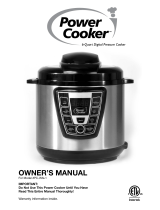 Power Cooker PC-WAL1 Owner's manual
Power Cooker PC-WAL1 Owner's manual
-
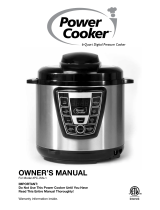 Power Cooker PC-WAL1 Owner's manual
Power Cooker PC-WAL1 Owner's manual
-
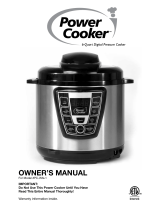 Power Cooker PC-WAL1 Owner's manual
Power Cooker PC-WAL1 Owner's manual
-
Tristar Power Cooker PC-TRI6 Owner's manual
-
Fagor 670041930 User manual
-
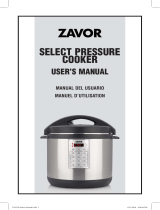 Zavor 124706 User manual
Zavor 124706 User manual
-
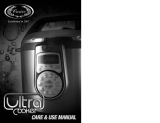 Carico Ultra Cooker Owner's manual
Carico Ultra Cooker Owner's manual
-
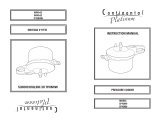 Continental Platinum CP43040 User manual
Continental Platinum CP43040 User manual



































